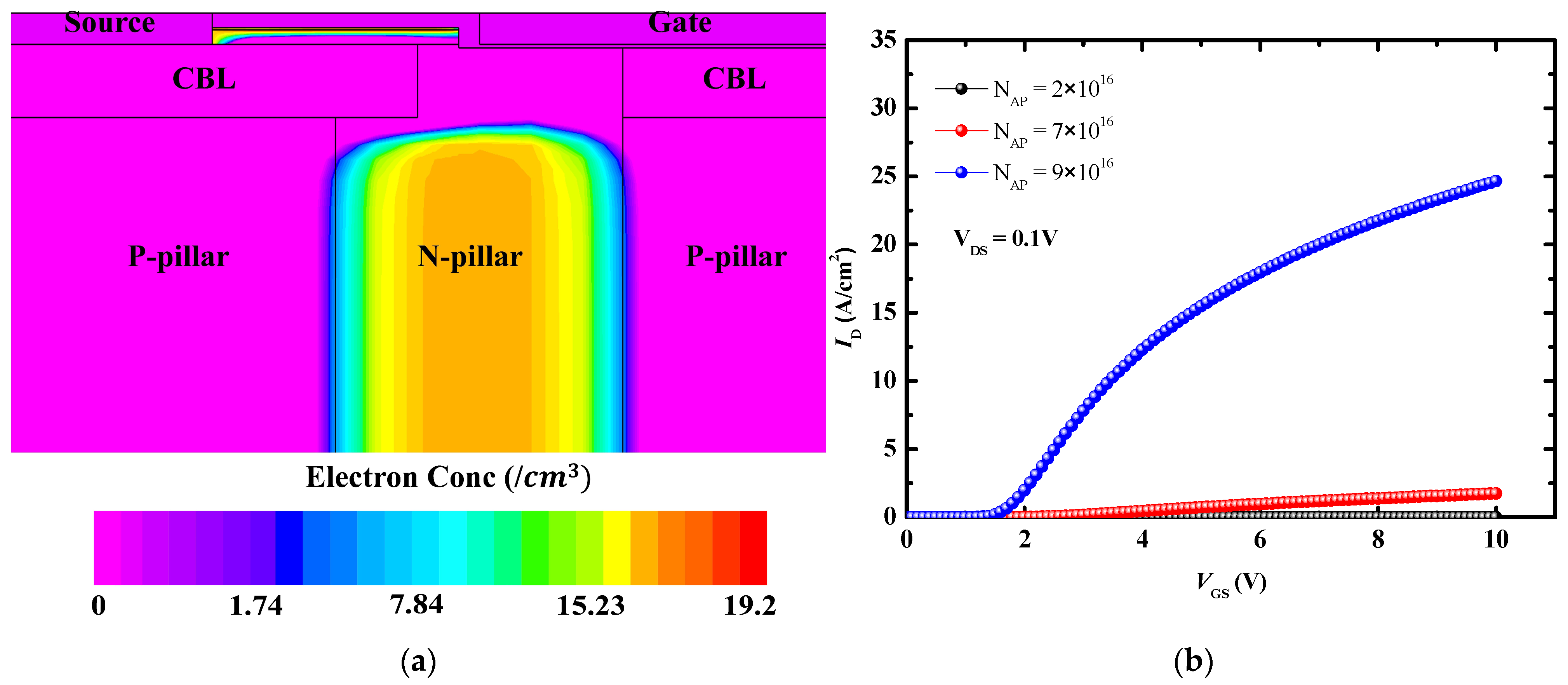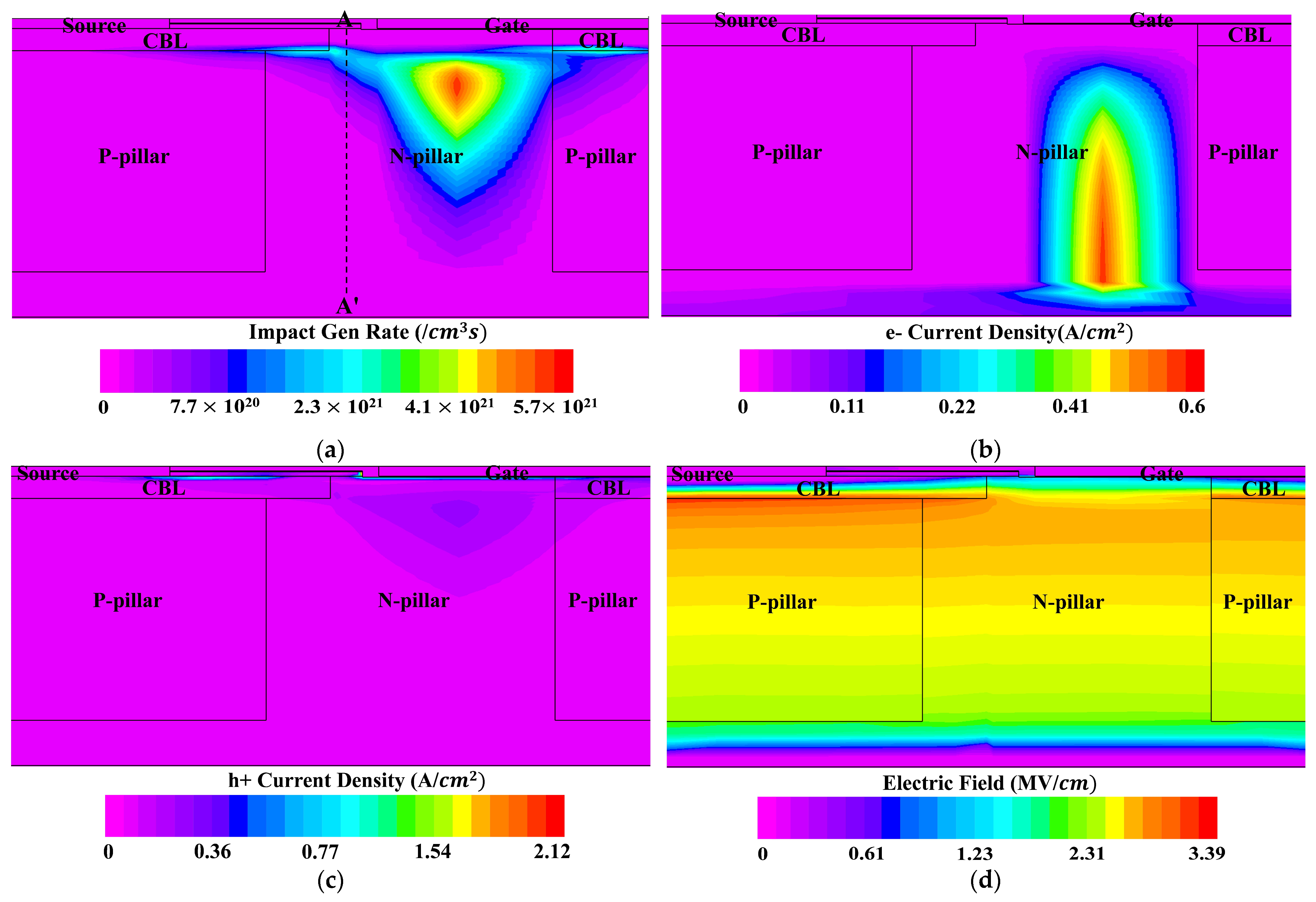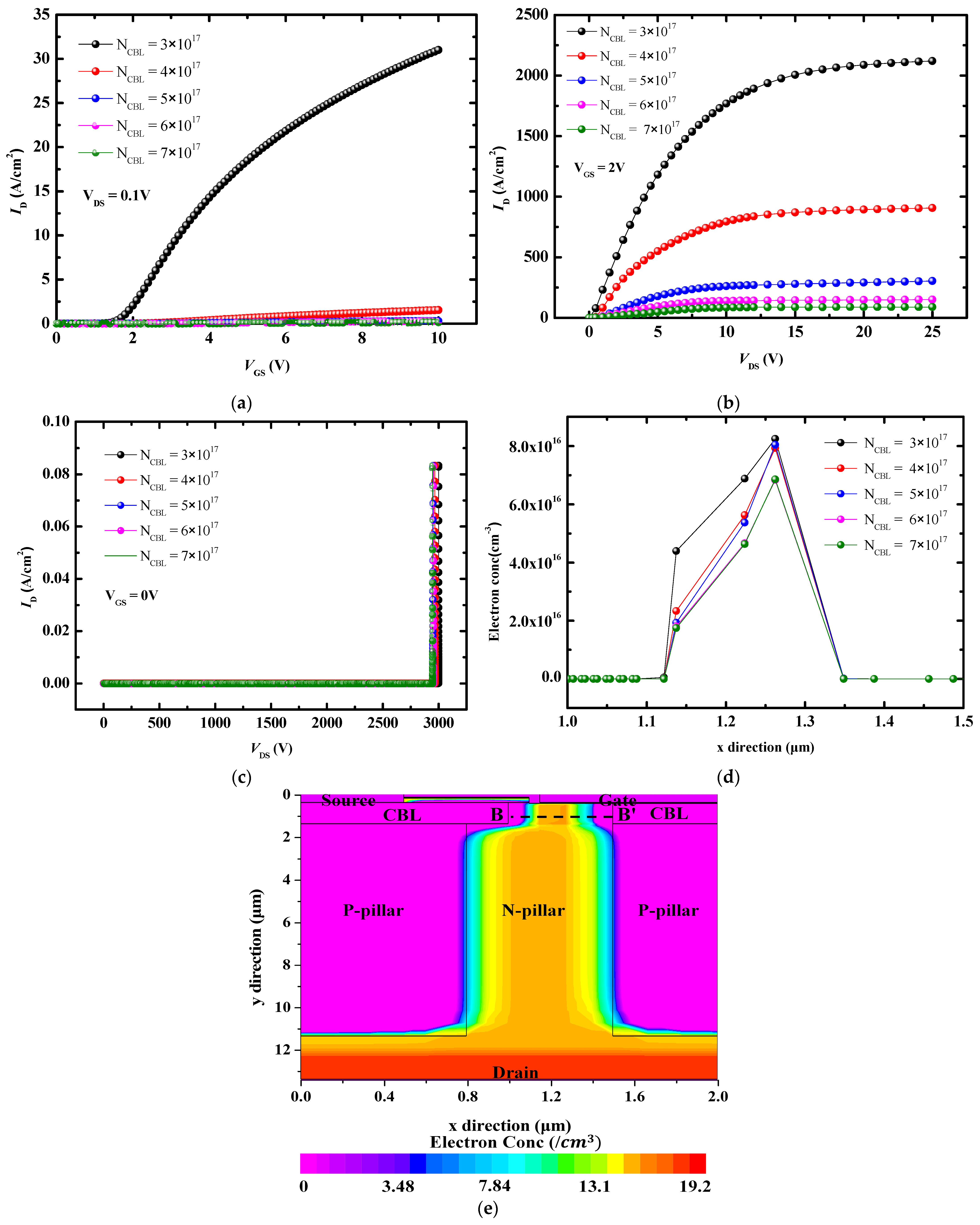Normally-Off Trench-Gated AlGaN/GaN Current Aperture Vertical Electron Transistor with Double Superjunction
Abstract
:1. Introduction
2. Device Structure and Operation Mechanisms
3. Simulation Results and Discussion
3.1. Static Performance Based on CBL Doping Concentration
3.2. Static Performance Based on Aperture Length
3.3. Optimization of AlGaN/GaN CAVET with Double Superjunction
4. Conclusions
Author Contributions
Funding
Institutional Review Board Statement
Informed Consent Statement
Data Availability Statement
Conflicts of Interest
References
- Buffolo, M.; Bai, P.; Zhang, Y.; Otake, H.; Egami, S.; Ohta, H.; Nanishi, Y.; Takasu, H. Review and Outlook on GaN and SiC Power Devices: Industrial State-of-the-Art, Applications, and Perspectives. IEEE Trans. Electron Devices 2024, 71, 1334–1355. [Google Scholar] [CrossRef]
- Bai, P.; Zhang, Y.; Otake, H.; Egami, S.; Ohta, H.; Nanishi, Y.; Takasu, H. A Novel Trench-Gated Vertical GaN Transistor With Dual-Current-Aperture by Electric-Field Engineering for High Breakdown Voltage. IEEE Trans. Electron Devices 2022, 69, 1219–1225. [Google Scholar] [CrossRef]
- Zhang, Y.; Otake, H.; Egami, S.; Ohta, H.; Nanishi, Y.; Takasu, H. Electrothermal Simulation and Thermal Performance Study of GaN Vertical and Lateral Power Transistors. IEEE Trans. Electron Devices 2013, 60, 2224–2230. [Google Scholar] [CrossRef]
- Otake, H.; Egami, S.; Ohta, H.; Nanishi, Y.; Takasu, H. GaN-Based Trench Gate Metal Oxide Semiconductor Field Effect Transistors with Over 100 cm2/(V·s) Channel Mobility. Jpn. J. Appl. Phys. 2007, 46, L599. [Google Scholar] [CrossRef]
- He, W.; Li, J.; Liao, Z.; Lin, F.; Wu, J.; Wang, B.; Wang, M.; Liu, N.; Chiu, H.-C.; Kuo, H.-C. 1.3 kV Vertical GaN-Based Trench MOSFETs on 4-Inch Free Standing GaN Wafer. Nanoscale Res. Lett. 2022, 17, 14. [Google Scholar] [CrossRef]
- Ben-Yaacov, I.; Seck, Y.-K.; Mishra, U.K.; DenBaars, S.P. AlGaN/GaN Current Aperture Vertical Electron Transistors with Re-Grown Channels. J. Appl. Phys. 2004, 95, 2073–2078. [Google Scholar] [CrossRef]
- Ji, D.; Zhang, Y.; Li, Y.; Li, M.; Liu, X.; Zhang, Q.; Li, X. Dynamic Modeling and Power Loss Analysis of High-Frequency Power Switches Based on GaN CAVET. IEEE Trans. Electron Devices 2016, 63, 4011–4017. [Google Scholar] [CrossRef]
- Shibata, D.; Kajitani, R.; Ogawa, M.; Tanaka, K.; Tamura, S.; Hatsuda, T.; Ishida, M.; Ueda, T. 1.7 kV/1.0 mΩ·cm2 Normally-Off Vertical GaN Transistor on GaN Substrate with Regrown p-GaN/AlGaN/GaN Semipolar Gate Structure. In Proceedings of the 2016 IEEE International Electron Devices Meeting (IEDM), San Francisco, CA, USA, 3–7 December 2016; pp. 248–251. [Google Scholar]
- Luo, C.; Zhang, Y.; Li, Y.; Zhao, X.; Hu, H. Novel High-Voltage GaN CAVET with High Threshold Voltage and Low Reverse Conduction Loss. Microelectron. J. 2024, 148, 106195. [Google Scholar] [CrossRef]
- Mishra, U.K.; Zhang, Y.; Ambacher, O.; Gossmann, H.-J.; Schaff, W. AlGaN/GaN HEMTs—An Overview of Device Operation and Applications. Proc. IEEE 2002, 90, 1022–1031. [Google Scholar] [CrossRef]
- Ji, D.; Laurent, M.A.; Agarwal, A.; Li, W.; Mandal, S.; Keller, S.; Chowdhury, S. Normally OFF Trench CAVET With Active Mg-Doped GaN as Current Blocking Layer. IEEE Trans. Electron Devices 2017, 64, 805–812. [Google Scholar] [CrossRef]
- Ambacher, O.; Albrecht, M.; Lischka, K.; Stutzmann, M.; Muller, G.; Zollner, S.; Tietjen, S.; Badra, K.; Hillebrand, R. Two-Dimensional Electron Gases Induced by Spontaneous and Piezoelectric Polarization Charges in N- and Ga-Face AlGaN/GaN Heterostructures. J. Appl. Phys. 1999, 85, 3222–3233. [Google Scholar] [CrossRef]
- Ma, Y.; Xiao, M.; Du, Z.; Wang, L.; Carlson, E.; Guido, L.; Wang, H.; Wang, L.; Luo, Y.; Zhang, Y. Activating Thick Buried p-GaN for Device Applications. IEEE Trans. Electron Devices 2022, 69, 4224–4230. [Google Scholar] [CrossRef]
- Kachi, T.; Hirukawa, K.; Narita, T.; Sakurai, H.; Sumida, K.; Matys, M.; Horita, M.; Kataoka, K.; Ikarashi, N.; Sierakowski, K.; et al. Process Engineering of GaN Power Devices via Selective-Area p-Type Doping with Ion Implantation and Ultra-High-Pressure Annealing. J. Appl. Phys. 2022, 132, 130901. [Google Scholar] [CrossRef]
- Silvaco Inc. ATLAS User’s Manual; Silvaco Inc.: Santa Clara, CA, USA, 2019. [Google Scholar]
- Liu, T.; Hu, S.; Wang, J.; Guo, G.; Luo, J.; Wang, Y.; Guo, J.; Huo, Y. An Investigation of Electric Field and Breakdown Voltage Models for a Deep Trench Superjunction SiC VDMOS. IEEE Access 2019, 7, 132087–132097. [Google Scholar] [CrossRef]
- Kang, H.; Udrea, F. On the Specific On-State Resistance of Superjunction MOSFETs with a Compensated Pillar. IEEE Electron Device Lett. 2018, 39, 1746–1749. [Google Scholar] [CrossRef]
- Chu, R.; Zhang, X.; Zhang, Y.; Yao, H.; Chen, X.; Fu, X. 1200-V Normally Off GaN-on-Si Field-Effect Transistors with Low Dynamic On-Resistance. IEEE Electron Device Lett. 2011, 32, 632–634. [Google Scholar]
- Mishra, U.K.; Sukhdeo, N.; Shur, M.S.; Tang, J.; Xie, H. GaN-Based RF Power Devices and Amplifiers. Proc. IEEE 2008, 96, 287–305. [Google Scholar] [CrossRef]
- Ma, J.; Guo, Z.; Sun, H.; Li, Y.; Zhang, M.; Xia, X.; Xia, F.; Tan, X.; Huang, Z.; Ding, X.; et al. Study of GaN-Based Superjunction CAVET with Dipole Layer to Further Improve On-Resistance and Breakdown Voltage. J. Electron. Mater. 2022, 51, 110–118. [Google Scholar] [CrossRef]
- Mao, W.; Wang, H.; Shi, P.; Yang, C.; Zhang, Y.; Zheng, X.; Wang, C.; Zhang, J.; Hao, Y. Study of GaN-based Step-Doping Superjunction CAVET for Further Improvement of Breakdown Voltage and Specific On-Resistance. Semicond. Sci. Technol. 2018, 33, 025005. [Google Scholar] [CrossRef]
- Uren, M.J.; Hill, A.D.; Mohammadi, A.; Hafez, N. Punch-Through in High Voltage AlGaN/GaN HEMTs: The Role of Buffer Design. IEEE Trans. Electron Devices 2017, 64, 2826–2832. [Google Scholar] [CrossRef]
- Bahat-Treidel, E.; Hilt, O.; Brunner, F.; Wurfl, J.; Trankle, G. Punchthrough-Voltage Enhancement of AlGaN/GaN HEMTs Using AlGaN Double-Heterojunction Confinement. IEEE Trans. Electron Devices 2008, 55, 3354–3359. [Google Scholar] [CrossRef]
- Ueda, T. GaN Power Devices: Current Status and Future Challenges. Jpn. J. Appl. Phys. 2019, 58, SC0804. [Google Scholar] [CrossRef]
- Kozak, J.P.; Zhang, R.; Porter, M.; Song, Q.; Liu, J.; Wang, B.; Wang, R.; Saito, W.; Zhang, Y. Stability, Reliability, and Robustness of GaN Power Devices: A Review. IEEE Trans. Power Electron. 2023, 38, 1234–1245. [Google Scholar] [CrossRef]
- Xiao, M.; Zhang, R.; Dong, D.; Wang, H.; Zhang, Y. Design and Simulation of GaN Superjunction Transistors With 2-DEG Channels and Fin Channels. IEEE J. Emerg. Sel. Top. Power Electron. 2019, 7, 1475–1485. [Google Scholar] [CrossRef]
- Wang, H.; Zhang, Y.; Li, Z.; Xu, J.; Zhang, Q.; Wu, Z. Study of High Breakdown Voltage GaN-Based Current-Aperture Vertical Electron Transistor with Source-Connected Field-plates for Power Applications. Semicond. Sci. Technol. 2018, 33, 075008. [Google Scholar] [CrossRef]
- Li, Y.; Xu, L.; Guo, Z.; Sun, H. Study of High-Performance GaN-Based Trench CAVET with Stepped Doping Microstructure. Micromachines 2022, 13, 1273. [Google Scholar] [CrossRef]
- Wei, J.; Wang, Y.; Zhang, M.; Jiang, H.; Chen, K.J. High-Speed Power MOSFET with Low Reverse Transfer Capacitance Using a Trench/Planar Gate Architecture. In Proceedings of the 2017, 29th International Symposium on Power Semiconductor Devices and IC’s (ISPSD), Sapporo, Japan, 28 May–1 June 2017; pp. 12–15. [Google Scholar]








| Symbol | Statement | Value |
|---|---|---|
| WCell | Cell pitch | 2 μm |
| tCBL | CBL thickness | 1 μm |
| tDrift | Thickness of drift layer | 10 μm |
| LA | Aperture length | 0.7 μm |
| LCBL | CBL length | 0.3 μm |
| t(AlGaN/GaN) | AlGaN/GaN thickness | 30/200 nm |
| LP | p-pillar length | 0.8 μm |
| NU | UID GaN doping concentration | cm−3 |
| NP | p-pillar GaN doping concentration | cm−3 |
| NN | n-pillar GaN doping concentration | cm−3 |
| NCBL | CBL doping concentration | cm−3 |
| NAP | Aperture GaN doping concentration | cm−3 |
| Material | Statement | Value |
|---|---|---|
| GaN | Electron mobility | 1200 cm2/V∙s |
| Hole mobility | 10 cm2/V∙s | |
| Lifetime of electron | s | |
| Lifetime of hole | s | |
| Saturation velocity | cm/s | |
| AlGaN | Electron mobility | 600 cm2/V∙s |
| Hole mobility | 10 cm2/V∙s | |
| Lifetime of electron | s | |
| Lifetime of hole | s |
| Device | Super-Junction | Drift Layer Thickness [μm] | Breakdown Voltage [V] | Specific on Resistance [mΩ·cm−2] | BFOM [GW·cm−2] | Reference |
|---|---|---|---|---|---|---|
| EBP-CAVET | X | 7 | 1660 | 1.19 | 2.32 | [9] |
| DCAVET | X | 6 | 1504 | 0.77 | 2.94 | [2] |
| SFP-CAVET | O | 15 | 3610 | 2.25 | 5.97 | [27] |
| SDS-CAVET | O | 15 | 2523 | 1.34 | 4.77 | [28] |
| CAVET w/DSJ | O | 10 | 2933 | 1.29 | 6.66 | this work |
Disclaimer/Publisher’s Note: The statements, opinions and data contained in all publications are solely those of the individual author(s) and contributor(s) and not of MDPI and/or the editor(s). MDPI and/or the editor(s) disclaim responsibility for any injury to people or property resulting from any ideas, methods, instructions or products referred to in the content. |
© 2024 by the authors. Licensee MDPI, Basel, Switzerland. This article is an open access article distributed under the terms and conditions of the Creative Commons Attribution (CC BY) license (https://creativecommons.org/licenses/by/4.0/).
Share and Cite
Kim, J.-U.; Park, D.-Y.; Park, B.-J.; Hahm, S.-H. Normally-Off Trench-Gated AlGaN/GaN Current Aperture Vertical Electron Transistor with Double Superjunction. Technologies 2024, 12, 262. https://doi.org/10.3390/technologies12120262
Kim J-U, Park D-Y, Park B-J, Hahm S-H. Normally-Off Trench-Gated AlGaN/GaN Current Aperture Vertical Electron Transistor with Double Superjunction. Technologies. 2024; 12(12):262. https://doi.org/10.3390/technologies12120262
Chicago/Turabian StyleKim, Jong-Uk, Do-Yeon Park, Byeong-Jun Park, and Sung-Ho Hahm. 2024. "Normally-Off Trench-Gated AlGaN/GaN Current Aperture Vertical Electron Transistor with Double Superjunction" Technologies 12, no. 12: 262. https://doi.org/10.3390/technologies12120262
APA StyleKim, J.-U., Park, D.-Y., Park, B.-J., & Hahm, S.-H. (2024). Normally-Off Trench-Gated AlGaN/GaN Current Aperture Vertical Electron Transistor with Double Superjunction. Technologies, 12(12), 262. https://doi.org/10.3390/technologies12120262







